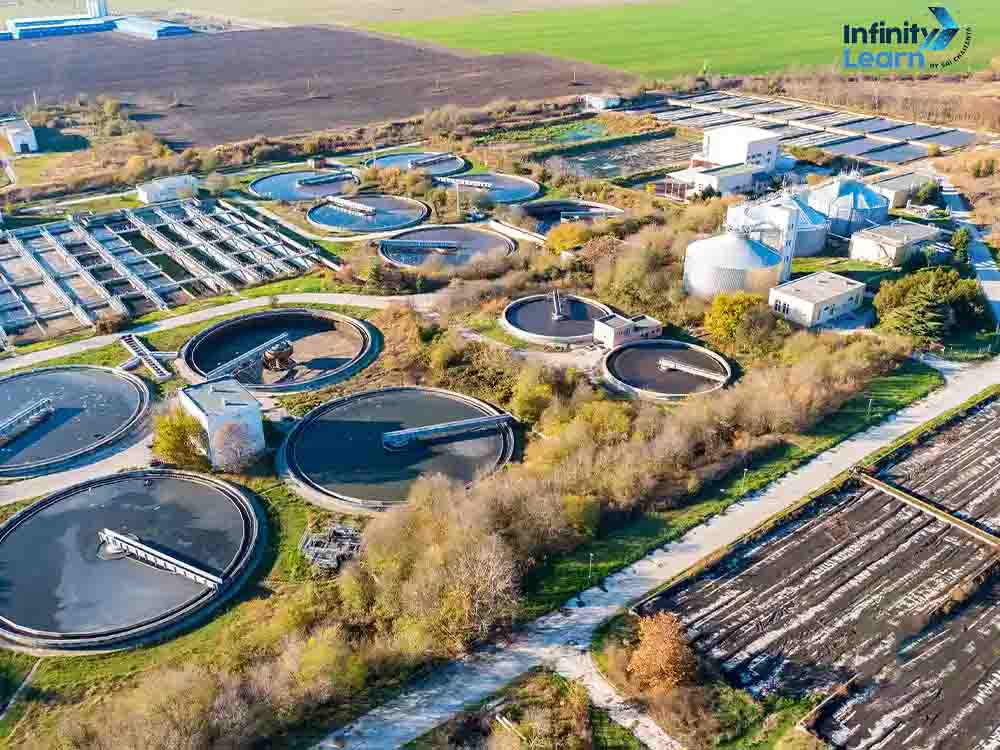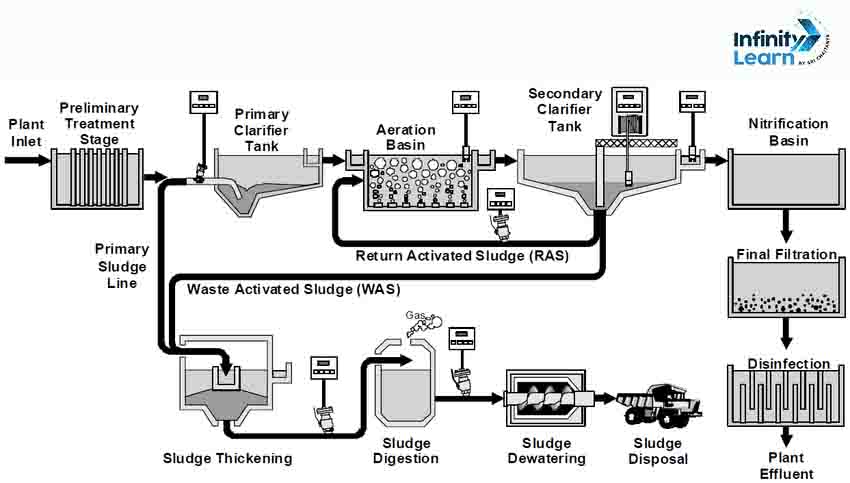Table of Contents
Sewage treatment plants (STPs) play a crucial role in modern society by ensuring wastewater is treated to remove contaminants before being released back into the environment. This article will delve into the definition, process, uses, and benefits of sewage treatment plants, providing a comprehensive understanding of their importance.

Sewage Treatment Plant – Overview
| Plant Name | Sewage Treatment Plant |
| STP Full Form | Sewage Treatment Plant |
| Description | A facility designed to treat and remove contaminants from wastewater, including household sewage and industrial effluent, through physical, chemical, and biological processes to produce environmentally safe treated wastewater (or treated effluent) and solid waste (or treated sludge). |
| STP Uses |
|
Sewage Treatment Plant Definition
A sewage treatment plant, also known as a wastewater treatment plant, is a facility designed to treat and remove contaminants from wastewater, including household sewage and industrial effluent. The primary goal is to produce environmentally safe treated wastewater (or treated effluent) and solid waste (or treated sludge).
Also Check: Bio Medical Waste Management
Types of Sewage Treatment Plants
Sewage treatment plants (STPs) are designed to treat wastewater and remove contaminants before it is released into the environment. There are various types of sewage treatment plants, each employing different processes and technologies to achieve this goal. Below are the main types of sewage treatment plants:
- Conventional Activated Sludge Plant (CASP): It utilizes aerobic microorganisms in an aeration tank to break down organic matter. It includes primary sedimentation, secondary (activated sludge), and tertiary treatment stages. Effective in removing pollutants, it requires significant energy for aeration and produces substantial sludge .
- Extended Aeration System: A variation of CASP with longer aeration times, resulting in more stable sludge. While it produces less sludge and is more stable, it has higher energy consumption and a larger footprint .
- Sequencing Batch Reactor (SBR): Treats wastewater in batch cycles, combining aeration and sedimentation in a single tank. It offers operational flexibility and effective nutrient removal but requires careful cycle management .
- Membrane Bioreactor (MBR): It combines biological treatment with membrane filtration, providing high-quality effluent. Though it has a smaller footprint and produces very clean water, it involves high costs and potential membrane fouling issues .
- Moving Bed Biofilm Reactor (MBBR): It uses plastic media in an aeration tank to support biofilm growth, enhancing treatment efficiency. It is compact with low sludge production but has higher operational costs .
- Rotating Biological Contactor (RBC): Features rotating disks partially submerged in wastewater to support biofilm growth. It’s energy-efficient and simple but can be prone to mechanical failures .
- Constructed Wetlands: Mimics natural wetlands using vegetation and soil to treat wastewater. It has low operational costs and provides habitat creation but requires significant land area .
- Anaerobic Treatment Systems: It uses anaerobic microorganisms to treat wastewater, producing biogas. It has low sludge production and generates renewable energy but operates slower and can produce odors .
Also Check: Types of Waste
Sewage Treatment Plant Process
The sewage treatment process involves several stages to ensure the efficient removal of contaminants:
Preliminary Treatment
- Screening: Removes large solids such as sticks, rags, and debris.
- Grit Removal: Extracts sand, gravel, and other heavy particles.
Primary Treatment
Sedimentation: Allows heavier solids to settle at the bottom of large tanks, forming sludge, while the lighter substances float to the top to be skimmed off.
Secondary Treatment
- Biological Treatment: Utilizes microorganisms to break down organic matter in the wastewater. Common methods include activated sludge processes and trickling filters.
- Aeration: Introduces air to support the biological processes, helping microorganisms to digest pollutants more efficiently.
Tertiary Treatment
- Filtration: Further removes suspended particles and pathogens.
- Disinfection: Kills remaining harmful microorganisms using chlorine, ultraviolet light, or ozone.
- Nutrient Removal: Reduces levels of nitrogen and phosphorus to prevent environmental issues such as eutrophication.
Also Check: Cause of Solid Waste Pollution
Sludge Treatment
- Thickening: Concentrates the sludge by removing excess water.
- Digestion: Breaks down the sludge using anaerobic or aerobic processes.
- Dewatering: Further reduces water content, preparing the sludge for disposal or use as fertilizer.
Sewage Treatment Plant Flow Chart

Sewage Treatment Plant Uses
Sewage treatment plants are used for various purposes, including:
- Environmental Protection: Ensures that wastewater is treated before being discharged into natural water bodies, protecting aquatic ecosystems.
- Public Health: Reduces the spread of waterborne diseases by removing harmful pathogens from sewage.
- Water Reuse: Provides treated water for agricultural irrigation, industrial processes, and landscape maintenance.
- Resource Recovery: Recovers valuable resources such as biogas from sludge digestion and nutrients for use as fertilizers.
Sewage Treatment Plant Diagram for Students

Benefits of Sewage Treatment Plant
Implementing and maintaining sewage treatment plants provide numerous benefits:
Environmental Benefits
- Reduces pollution in rivers, lakes, and oceans.
- Protects wildlife habitats and preserves biodiversity.
Public Health Benefits
- Minimizes the risk of exposure to hazardous contaminants.
- Prevents outbreaks of diseases such as cholera and dysentery.
Economic Benefits
- Creates job opportunities in plant operation and maintenance.
- Enhances property values in communities with efficient wastewater management systems.
Sustainability Benefits
- Promotes the recycling and reuse of water resources.
- Supports sustainable development goals by ensuring clean water and sanitation.
FAQs on Sewage Treatment Plant
What is a sewage treatment plant?
A sewage treatment plant (STP) is a facility designed to remove contaminants from wastewater and household sewage through physical, chemical, and biological processes, making the water safe for release into the environment.
What is the importance of a sewage treatment plant?
Sewage treatment plants protect public health by removing harmful contaminants and pathogens from wastewater, reduce environmental pollution, and enable the reuse of treated water for various purposes.
What is the sewage treatment plant cost?
The cost of a sewage treatment plant varies widely depending on its size, capacity, technology used, and location. It can range from thousands to millions of dollars for large-scale municipal plants.
What are the 4 types of sewage treatment?
The four main types of sewage treatment are primary treatment, secondary treatment, tertiary treatment, and sludge treatment.
What is the working principle of STP?
The working principle of an STP involves several stages: primary treatment to settle out solids, secondary treatment using biological processes to degrade organic matter, and tertiary treatment to further polish the effluent before it is released.
What is a sewage or sewerage treatment plant?
A sewage or sewerage treatment plant is a facility that processes wastewater from homes, industries, and businesses to remove contaminants and produce treated effluent safe for discharge or reuse.
What is the role of an STP sewage treatment plant?
The role of an STP is to treat wastewater to remove pollutants, reduce health risks, prevent environmental degradation, and enable the safe reuse of treated water.
How does a sewage treatment plant work?
A sewage treatment plant works by initially screening and settling solids, followed by biological treatment to degrade organic matter, and finishing with advanced processes like filtration and disinfection to ensure the effluent is safe for discharge.








